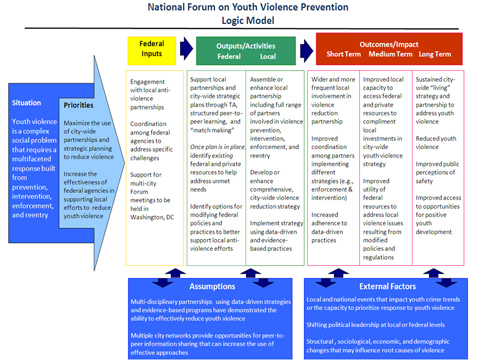National Forum Strategic Plan 2011-2015
Logic Model
Click the image for a larger version.
National Forum on Youth Violence Prevention Logic Model
Situation:
- Youth violence is a complex social problem that requires a multifaceted response built from prevention, intervention, enforcement, and re-entry.
Priorities:
- Maximize the use of city-wide partnerships and strategic planning to reduce violence.
- Increase the effectiveness of federal agencies in supporting local efforts to reduce youth violence.
Federal inputs:
- Engagement with local anti-violence partnerships
- Coordination among federal agencies to address specific challenges
- Support for multi-city Forum meetings to be held in Washington, DC
Assumptions:
- Multi-disciplinary partnerships, using data driven strategies and evidence-based programs, have demonstrated the ability to effectively reduce youth violence
- Multiple city networks provide opportunities for peer-to-peer information-sharing that can increase the use of effective approaches
Outputs and Activities – Federal:
- Support local partnerships and city-wide strategic plans through TA, structured peer-to-peer learning, and “match making”
- Once plan is in place, identify existing federal and private resources to help address unmet needs
- Identify options for modifying federal policies and practices to better support local anti-violence efforts.
Outputs and Activities – Local:
- Assemble or enhance local partnership including full range of partners involved in violence prevention, intervention, enforcement, and reentry
- Develop or enhance comprehensive, city-wide violence reduction strategy
- Implement strategy using data-driven and evidence-based practices
Outcomes and Impact – Short Term:
- Wider and more frequent local involvement in violence reduction partnership
- Improved coordination among partners implementing different strategies (e.g., enforcement and intervention)
- Increased adherence to data-driven practices
Outcomes and Impact – Medium Term:
- Improved local capacity to access federal and private resources to complement local investments in city-wide youth violence strategy
- Improved utility of federal resources to address local violence issues resulting from modified policies and regulations
Outcomes and Impact – Long Term:
- Sustained city-wide “living” strategy and partnership to address youth violence
- Reduced youth violence
- Improved public perceptions of safety
- Improved access to opportunities for positive youth development
External Factors:
- Local and national events that impact youth crime trends or the capacity to prioritize response to youth violence
- Shifting political leadership at local or federal levels
- Structural, sociological, economic, and demographic changes that may influence root causes of violence


